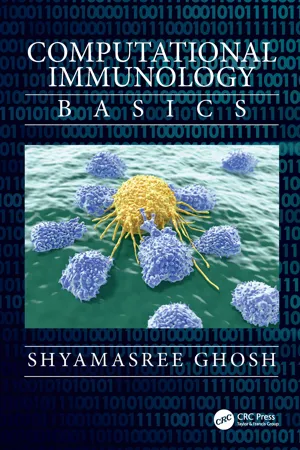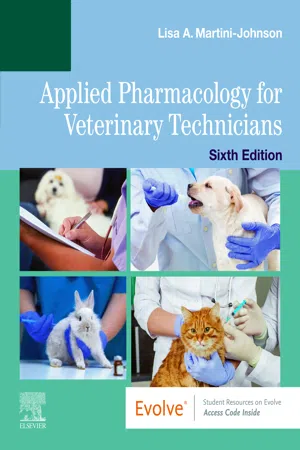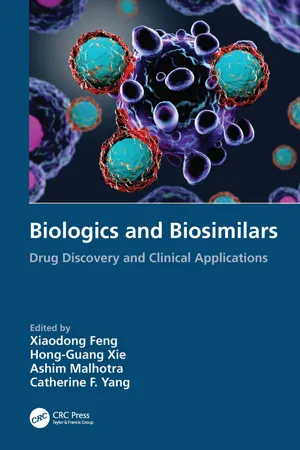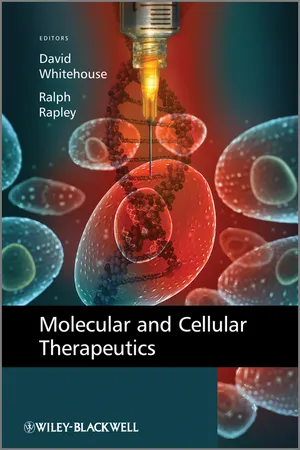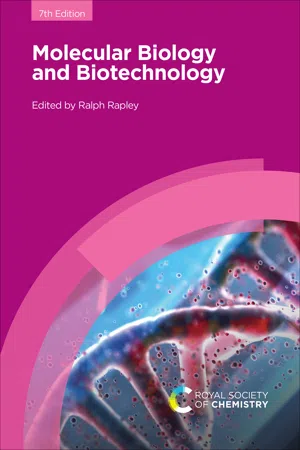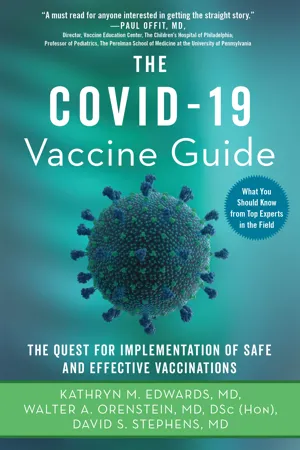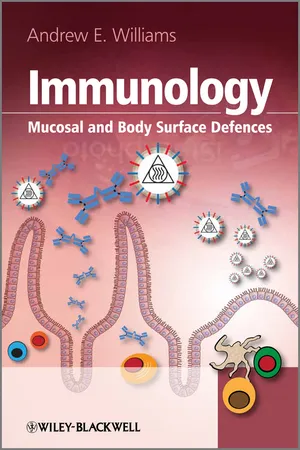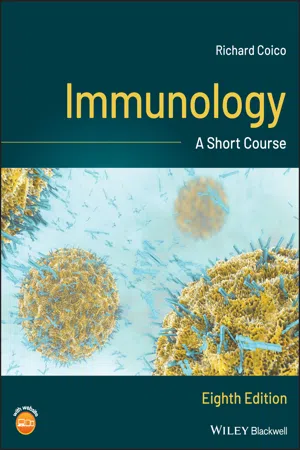Types of Vaccines
Vaccines can be categorized into several types, including live attenuated vaccines, inactivated vaccines, subunit, conjugate, toxoid, and mRNA vaccines. Live attenuated vaccines contain weakened forms of the virus or bacteria, while inactivated vaccines use killed pathogens. Subunit vaccines contain only specific antigens, while conjugate vaccines combine antigens with a carrier protein. Toxoid vaccines use inactivated toxins, and mRNA vaccines deliver genetic material to produce an immune response.
10 Key excerpts on "Types of Vaccines"
- eBook - ePub
Computational Immunology
Basics
- Shyamasree Ghosh(Author)
- 2019(Publication Date)
- CRC Press(Publisher)
Design of liposomes and incorporation of protein antigens into micelles or lipid vesicles or immunostimulating complexes or by mixing proteins in detergents with the subsequent removal of the detergent forming micelles are some strategies of vaccine design. The hydrophilic residues of proteins, orient towards the aqueous environment and the hydrophobic residues towards the centre. Liposomes containing protein antigen are prepared by mixing proteins with phospholipid suspension forming lipid bilayer vesicles. Incorporation of proteins into the bilayer with the hydrophilic residues exposed can be designed. Immunostimulating complexes (ISCOMs) are lipid carriers prepared by mixing protein with detergents and a glycoside termed Quil A. Membrane proteins from pathogens including influenza virus, measles virus, hepatitis B virus, and HIV have been used in design of vaccines in the form of micelles, liposomes, and ISCOMs. ISCOMs have the advantage of increased immunogenicity, and they can fuse with the plasma membrane to deliver the antigens intracellularly where it can be processed by the cytosolic pathway and thus induce CMI responses.8.7 VACCINES APPROVED BY THE U.S. FOOD AND DRUG ADMINISTRATION
Research and development of design of vaccines against several disorders are still ongoing across the globe. The Office of Vaccines Research and Review (OVRR) at the Centre for Biologics Evaluation and Research (CBER) at FD regulates preventative and therapeutic vaccines for human diseases [5 ]. The US. Food and Drug Administration (FDA) has approved several vaccines (Table 8.5 ).8.8 VACCINES UNDER DEVELOPMENT
Different types of vaccine are being developed for the prevention of infectious diseases by triggering innate immune system and both arms of the adaptive immune system [7 ]. First, live, attenuated vaccines against measles, mumps, and chickenpox contain attenuated versions of the original pathogenic agent, producing a strong cellular and antibody responses and long-term memory. Inactivated vaccines like inactivated influenza vaccine produced by treating a pathogenic agent with chemicals, heat, or radiation increases stability but produce weaker immune responses and require booster shots to maintain immunity [8 ]. Subunit vaccines like recombinant hepatitis B vaccine include only epitopes that readily stimulate the immune system, and does not reveal adverse reactions. Toxoid vaccines like diphtheria and tetanus vaccines produced by inactivating bacterial toxins with formalin stimulate an immune response against the bacterial toxins. Conjugate vaccines like the Haemophilus influenzae type B (Hib) vaccine is a type of subunit vaccine in which the antigens or toxoids are linked to polysaccharides from the outer coating of that microbe to stimulate immunity. Naked DNA vaccines that stimulate immunity and is largely under research. The host cells producing the antigen and displaying it on their surfaces would stimulate the immune system to produce a strong humoral and cellular response to the microbial antigens. Naked DNA vaccines for influenza and herpes are being developed [9 ]. Recombinant vector vaccines are designed to deliver either an attenuated virus or microbe into host cells, mimicking a natural infection process. These antigens from the pathogenic microbe would be displayed on harmless microbe mimicking the pathogen and stimulating the immune system. Bacterial and viral-based recombinant vectors vaccines for HIV, rabies, and measles are being designed [9 ]. Attempts are being made for improvising the adjuvants, either by delivery systems like cationic microparticles or immune potentiators like cytokines or PRRs [10 - Lisa Martini-Johnson(Author)
- 2020(Publication Date)
- Saunders(Publisher)
17: Immunologic Drugs
Objectives- Principles of Vaccination,
- Common Vaccine Types That Produce Active Immunity,
- Inactivated (Killed),
- Live,
- Modified Live (Attenuated),
- Recombinant,
- Toxoid,
- Common Vaccine Types That Produce Passive Immunity,
- Antitoxin,
- Antiserum,
- Other Types of Vaccines,
- Autogenous Vaccine,
- Mixed Vaccine,
- Vaccine Storage, Handling, and Reconstitution,
- Administration of Vaccines,
- Vaccine Failure,
- Adverse Vaccination Responses,
- Core Versus Noncore Vaccines,
- Vaccinations for Preventive Health Programs,
- Canine,
- Feline,
- Equine,
- Bovine,
- Sheep and Goats,
- Immunotherapeutic Drugs,
- Immunostimulants,
- Complex Carbohydrates,
- Immunomodulatory Bacterins,
- Immunostimulants,
After studying this chapter, you should be able to1. Explain the principles associated with vaccination and describe the recommended locations for various feline vaccinations. 2. Describe the differences between infectious and noninfectious vaccines. 3. Discuss the advantages and disadvantages of the many different Types of Vaccines. 4. Discuss the storage, handling, and reconstitution of vaccines. 5. Describe the different routes of administration of vaccines. 6. Discuss vaccine failure and adverse vaccination responses that may occur. 7. List core and noncore vaccines used in various species, as well as common diseases that have available vaccines. 8. List and discuss drugs used in immunotherapy.Key Terms Active immunity Adjuvant Anaphylaxis Antibody Antigen Avirulent Bacterin Core vaccines Monovalent Noncore vaccines Passive immunity Polyvalent Preservative Recombinant DNA technology Toxoid VirulencePrinciples of Vaccination
Keeping animals healthy through the proper use of immunization programs is an important aspect of veterinary medicine. Vaccine protocols (guidelines) recommended by the American Animal Hospital Association (AAHA), American Veterinary Medical Association (AVMA), American Association of Feline Practitioners (AAFP), and American Association of Equine Practitioners (AAEP) should be observed annually. Vaccination guidelines are a source of evidence-based recommendations and expert opinion provided by the AAHA Canine Vaccination Guidelines Task Force (AAHA, 2017 ) and AAFP feline vaccination guidelines. Veterinary technicians must have knowledge concerning vaccine types and the diseases against which animals are vaccinated. Clients ask many questions regarding this area of their pet’s care. As animals enter into their geriatric years, regular laboratory profiles should be done to determine the health of major organ systems. Preventive health care guidelines include a complete history, comprehensive physical examination, assessment, diagnostic plan, therapeutic plan, prevention plan, and a follow-up plan on the animal (JAAHA, 2011- eBook - ePub
Biologics and Biosimilars
Drug Discovery and Clinical Applications
- Xiaodong Feng, Hong-Guang Xie, Ashim Malhotra, Catherine F. Yang(Authors)
- 2022(Publication Date)
- CRC Press(Publisher)
5 ]. Drawing on his experience observing the milkmaids, Jenner predicted cowpox could hold the key to salvation. To test Jenner's predictions, Jenner injected components of a cowpox blister into an adolescent named James Phipps [4, 5]. Subsequently, Jenner exposed Phipps to variola virus (smallpox) multiple times and noted that Phipps never developed the disease that annihilated so many [4, 5]. Left with no symptoms, James Phipps gained full immunological protection to fend against smallpox infection and Jenner had performed the first account of contemporary vaccination [5]. Today, we can credit Jenner's unethical experiment to the development of modern-day vaccination.Vaccination is an active form of immunization in which an antigen is introduced to the body to provoke an immune response, and optimistically manifests protection and long-term memory against the foreign antigen. Vaccines undoubtedly have been a remarkable tool since the 18th century warding off and closely eradicating infectious diseases, such as smallpox. Vaccination saves approximately 2 to 3 million lives annually, according to the Centers for Disease Control and Prevention (CDC) [6 ].It is important to note that vaccines fall under the category of biologics rather than a typical drug. Biologics are classified as stemming from a living biological system and are often composed of larger, complex molecules such as saccharides, proteins, nucleic acids, cells, tissues, or an assortment of these entities [7 ]. Examples of biologics include vaccines, blood, and recombinant therapeutic proteins [7]. There is an underlying theme of mystery regarding all the components contained in biologics as not all attributes may be characterizable, making the need for biologic manufacturing to be more surveillant and controlled [8 ].In this chapter, we will discuss the basis of vaccines, provide examples demonstrating the various vaccine types, examine factors affecting vaccine accessibility, and will explore possible routes of vaccine evolution in relation to the concept of biosimilarity. Although there is currently active discussion regarding how to properly define biosimilarity in regard to vaccines, for the purpose of this chapter, we will define biosimilarity as a medicinal biological product with an active substance that closely resembles an original or a reference product, in terms of molecular composition and bioequivalence in pharmaceutical and clinical settings [9 - eBook - ePub
- Ian R. Tizard(Author)
- 2017(Publication Date)
- Saunders(Publisher)
24Vaccines and Their Production
Chapter OutlineTypes of Immunization Procedures,261Passive Immunization,261Active Immunization,263Living and Killed Vaccines, 264Inactivation, 264Attenuation, 265Modern Vaccine Technology,265Antigens Generated by Gene Cloning (Category I), 265Genetically Attenuated Organisms (Category II), 267Live Recombinant Organisms (Category III), 267Polynucleotide Vaccines (Category IV), 268Prime-Boost Strategies,269Reverse Vaccinology, 270Adjuvants,270Aluminum Salts, 270Saponin-Based Adjuvants, 271Water-in-Oil Emulsions, 271Particulate Adjuvants, 272Immunostimulatory Adjuvants, 272Combined Adjuvants, 273Learning ObjectivesAfter reading this chapter, you should be able to:• Describe how an animal can be made immune to infection by passive or active immunization. • Explain how passive immunization works, as well as its benefits and disadvantages. • Describe how active immunization works. • Compare the benefits and disadvantages of live versus inactivated vaccines. • List the advantages of cloned antigens. • Explain how adjuvants, when added to vaccines, enhance their effectiveness. • Describe the characteristics of an ideal vaccine. • Explain the process of attenuation. • Explain how targeted gene deletion is superior to earlier methods of attenuation. • Explain how polynucleotide vaccines work. • Define attenuation, adjuvants, modified live, DIVA vaccines, prime-boost, and reverse vaccinology. • Explain the importance of identifying essential and nonessential vaccines. • Understand what controls the duration of immunity. • Explain the benefits and disadvantages of adjuvants. • Explain the mechanisms by which common adjuvants work.Vaccination is by far the most efficient and cost-effective method of controlling infectious diseases in humans and animals. The eradication of smallpox and rinderpest from the globe, the elimination of hog cholera and brucellosis from many countries, and the control of diseases such as foot-and-mouth disease, canine distemper, rabies, influenza, and pseudorabies would not have been possible without the use of effective vaccines. Vaccines are among the greatest triumphs of modern medicine. - eBook - ePub
- David Whitehouse, Ralph Rapley(Authors)
- 2012(Publication Date)
- Wiley-Blackwell(Publisher)
There are several different types of DCs of which plasmacytoid DCs and myeloid/monocyte-derived DCs are the most important in T cell responses. DCs are critical to inducing activation of naive TH and CTLs on first exposure to a pathogen. Thus a vaccine must be taken up by DCs to initiate the primary T cell response. One other key feature of DCs is cross-presentation (cross-priming), where DCs present peptides from an exogenous source on both MHC class I and class II molecules. This may be achieved by different mechanisms involving uptake of infected cells, intracellular routing of exogenous protein from the endocytic pathway to the cytosolic pathway or transfer of MHC class I molecules expressing peptides from infected cells to the DCs. Cross-presentation of proteins encoded on plasmid DNA vaccines is central to the success of these Types of Vaccines. Various strategies considered later in this chapter, have been developed which target vaccine delivery to DCs to enhance the immunogenicity of vaccine.13.3 Vaccines in current use in humansCurrent vaccines which have been approved for use in humans have proven efficacy as well as generating much information on the nature and mechanisms of vaccine-induced immunity in humans. These vaccines are of three main types: live-, attenuated-, whole-organism vaccines, inactivated vaccines and subunit vaccines. Examples of each are considered in this section.13.3.1 Live-, attenuated-vaccinesThese vaccines use strains of the pathogen that have been attenuated, but retain features of the human strain. Attenuated strains may arise naturally and are typically strains which cause disease in non-human hosts but are less virulent in humans, or pathogenic strains may be attenuated through laboratory manipulation, to make them safe for use in humans. Attenuation can be achieved through growing the pathogen under abnormal conditions for the pathogen, and screening the isolated strains for loss of virulence while retaining immunogenicity. This strategy can be a time-consuming process. The development of the BCG strain, isolated by Calmette and Guerin in the 1920s took 13 years of culturing M. bovis. BCG is the most widely-used vaccine and elicits both strong B and T cell responses. However, the efficacy of BCG is highly variable; this is due partly, perhaps, to variations between vaccine preparations due to the fact that BCG has never been cloned. The only other approved, live, bacterial vaccine is the attenuated Salmonella typhi - eBook - ePub
- Ralph Rapley(Author)
- 2021(Publication Date)
- Royal Society of Chemistry(Publisher)
16 Vaccine Design Strategies: Pathogens to GenomesNiall McMullan*aa School of Life and Medical Sciences, University of Hertfordshire, College Lane, Hatfield, Hertfordshire AL10 9AB, UK, * E-mail: [email protected]Vaccines are undoubtedly one of the great triumphs of medical science. The global eradication of smallpox, once one of the most devastating infectious diseases of humankind, and the extensive control of various other infectious diseases bear testimony to the efficacy of vaccines. Much of this success employed classical vaccine designs, namely live attenuated vaccines as used for smallpox, measles, mumps and rubella (MMR), the BCG tuberculosis vaccine and the Sabin polio vaccine, and inactivated vaccines such as the Salk polio vaccine. Since then, subunit vaccines based on isolated macromolecules, including toxoid vaccines against tetanus, diphtheria and pertussis and conjugate vaccines against several forms of bacterial meningitis, have been developed. The advent of recombinant DNA technology and the first recombinant protein vaccine, the hepatitis B vaccine introduced in the 1980s, heralded a paradigm shift in vaccine design – no longer was it necessary to culture the pathogen. This millennium saw the introduction of recombinant protein vaccines against human papillomavirus (HPV) and meningitis B (MenB). Despite these successes, the persistence of malaria, HIV/AIDS and hepatitis C along with the emergence of novel zoonotic infections such as the devastating outbreaks of Ebola virus disease and the coronavirus outbreaks, including severe acute respiratory syndrome (SARS), Middle East respiratory syndrome (MERS) and Covid-19, serve as a reminder of the need for new vaccine technologies. At the forefront of this are recombinant vector vaccines and nucleic acid vaccines supported by dedicated bioinformatics tools. This chapter provides an overview of the immunology of vaccines and the range of vaccine design strategies currently being employed.
16.1 Introduction
Prophylactic vaccination is the key mechanism for the control and prevention of infectious diseases. At a community level, the greater the number of people vaccinated against a contagious disease, the fewer safe hosts will exist for the pathogen to replicate and the smaller will be the risk of transmission. A global vaccination programme instigated in the twentieth century brought about the eradication of smallpox, a terrifying scourge of humankind for thousands of years, and in so doing has prevented millions of deaths. Similarly, mass vaccination programmes have now confined polio, once a common global disease, to a few regions. Common childhood diseases such as measles, mumps and rubella are now extensively controlled, although fears about the MMR vaccine in the 1990s still bear a legacy. The 1980s brought the introduction of the highly effective hepatitis B vaccine, the first protein vaccine produced by recombinant DNA technology. Some 20 years later, recombinant protein vaccines against virulent human papillomavirus (HPV) strains, the primary cause of cervical cancer and other cancers, were introduced into the school vaccination programme in several countries. Common bacterial diseases including diphtheria, pertussis (whooping cough), tetanus and several types of bacterial meningitis have also been extensively controlled in many countries due to childhood vaccination programmes. Most of the above vaccines are administered as combined vaccines, so reducing the number of injections needed. The main factor in the success of the anti-viral vaccines mentioned above is their ability to elicit high serum titres of neutralising antibodies that bind to the proteins on the viral particle that facilitate cell entry. This is a highly effective strategy provided that the pathogen is not prone to significant mutations which allow evasion of specific antibodies, as is the case with human immunodeficiency virus (HIV) and hepatitis C virus (HCV). HIV and HCV, in common with all viral pathogens, are able to subvert aspects of innate immunity, such as preventing interferon (IFN) responses, but additionally HIV and HCV can disrupt adaptive immune processes. - eBook - ePub
The Covid-19 Vaccine Guide
The Quest for Implementation of Safe and Effective Vaccinations
- Kathryn M. Edwards, Walter A. Orenstein, David S. Stephens(Authors)
- 2021(Publication Date)
- Skyhorse(Publisher)
Chapter 2 Introduction to Vaccines and VaccinologyV accines are the most cost-effective intervention for preventing human disease. What is a vaccine? How does it work? How do vaccines protect?A vaccine is a substance, such as an inactivated protein from an infectious organism, that when given to a person induces an active immune response to prevent or mitigate a disease. Your immune system acts as an army. The immune system ideally detects the foreign invading germ (i.e., virus, bacterium, fungus), generally called a “pathogen,” and destroys it or contains it so that it cannot cause disease. What a vaccine does is give the immune system practice so that when it encounters the real pathogen, it is ready. Without practice from the vaccine, the pathogen can overwhelm an unprepared immune system, causing serious illness.The immune system can protect against infection and disease in two different ways. First, it can secrete immune proteins, called antibodies, into blood or tissues that bind to the invading pathogen and prevent it from multiplying or invading cells of the human body and enhancing the uptake of the pathogens into special cells (“phagocytes”) which destroy the pathogen. This aspect of the immune system is often called the humoral immune system. Critical players in this response are B cells and specialized B cells called plasma cells. The plasma cells produce the antibodies that circulate in the blood and other body fluids and tissues, which when encountering the pathogen neutralize it or bind to it, facilitating destruction of the pathogen by other cells of the immune system.Second, the immune system consists of specialized cells, called T cells, which destroy infected human cells and prevent the pathogen from spreading and causing serious disease. This aspect of the immune system is called the cellular immune system.A number of vaccines include substances called adjuvants or immune system helpers. These adjuvants enhance the immune response to the vaccine. In the United States, the most common adjuvants are aluminum-based compounds. But an increasing number of vaccines have other new adjuvants that stimulate immunity, particularly in the elderly or those with less-robust immune responses (see https://www.cdc.gov/vaccinesafety/concerns/adjuvants.html - eBook - ePub
Immunology
Mucosal and Body Surface Defences
- Andrew E. Williams(Author)
- 2011(Publication Date)
- Wiley(Publisher)
The current influenza virus vaccine, administered to high-risk populations in order to prevent epidemics of the flu, is based on inactivated virus. The influenza vaccine is trivalent and consists of three different virus strains, which are chemically inactivated. The influenza A virus strain(s) (highly pathogenic) likely to circulate in the following season are predicted and incorporated into the vaccine together with an influenza B virus strain (mildly pathogenic). Influenza viruses are identified by the type of haemagglutinin and neuraminidase (H and N) proteins they possess. For example, the current vaccine contains H1N1 and H3N2 virus haplotypes plus a strain of influenza B virus (such as the Beijing or Hong Kong strain). However, the inactivated influenza vaccine is not always protective, due to changes in the influenza virus strain as a result of antigenic drift (single mutations in the H and N genes) or antigenic shift (re-assortments of whole gene segments, e.g H3N2 to H5N2). The vaccine is then rendered non-protective as the immune system has never encountered the new virus strain and so the threat of an influenza epidemic or even a pandemic remains. Recent concerns have arisen due to geographically isolated human outbreaks of H5N1 virus, a haplotype thought only to be a problem in birds. Efforts are now being made to produce a H5N1 virus vaccine, although this virus is toxic to chicken embryos, the preferred medium for vaccine virus growth.An example of an inactivated bacterial vaccine is the formaldehyde inactivated whole-cell pertussis vaccine (WCPV) administered in childhood for protection against whooping cough. This was first administered in 1914 in the USA and consists of inactivated Bordetella pertussis absorbed onto aluminium salt as an adjuvant. WCPV is usually given in combination with diptheria toxoid and tetanus toxoid (DTwP). A toxoid is the chemically inactivated form of the toxin that causes disease. Although the DTwP vaccine was responsible for a massive decline in the incidence of whooping cough, diptheria and tetanus, some individuals had adverse reactions to the vaccine. The preferred trivalent diptheria, tetanus, pertussis (DTP) vaccine contains an acellular pertussis vaccine (DTaP) containing one or more inactivated components B. pertussis , including the toxin and filamentous haemagglutinin antigen. However, the DTaP vaccine is less efficacious than the DTwP vaccine and requires repeated immunizations.17.15 Polysaccharide VaccinesPolysaccharide vaccines are also known as conjugate vaccines and consist of bacterial polysaccharides conjugated to proteins. They have been very successful in preventing diseases caused by certain bacteria that possess a polysaccharide capsule, such as Neisseria meningititis (meningitis), Haemophilus influenzae type b (meningitis) and Streptococcus pneumoniae - eBook - ePub
- M. Julia B. Felippe(Author)
- 2015(Publication Date)
- Wiley-Blackwell(Publisher)
Killed or inactivated vaccines are easier to manufacture than live vaccines (Ellis, 2008), are more stable than live vaccines, and cannot revert to the virulent form (Meeusen, 2007), making them safer for immunosuppressed animals. Inactivated vaccines usually require multiple injections to elicit an immune response (Minke, 2004; Tizard, 2009), but induce less adverse reactions. In general, they induce humoral immune responses (Meeusen, 2007) but, when combined with an adjuvant or a delivery system, they may stimulate CTLs (Ellis, 2008).Immunization with an inactivated vaccine against West Nile virus has been shown to provide protection against severe disease (Davidson, 2005; Gardner, 2007; Salazar, 2004; Seino, 2007). Several inactivated vaccines are commercially available for use in horses in the US, in both monovalent and multivalent formats. Examples of such vaccines are those against EHV-1, EHV-4, EIV, equine encephalitis viruses (Eastern, Western, and Venezuelan), West Nile virus, rotavirus, Strep. equi, Neoreckettsia risticii, and rabies virus (Table 29.1 ).29.2.1.3 Protein or subunit vaccines
Subunit vaccines are those that combine a portion (subunit) of the pathogen that causes a disease (Roth, 2001), composed of antigens purified from microbes or inactivated toxins, usually combined with an adjuvant (Abbas, 2007a). Evidence exists that toxins can be rendered harmless without loss of immunogenicity, and these toxins can induce strong antibody responses (Abbas, 2007a). For example, bacterial-extract vaccines against Strep. equi, when administered intramuscularly or subcutaneously, elicit serum antibody responses 7–10 days later (Sweeney, 2005).Advantages of subunit vaccines include increased safety without the risk of reverting back to virulence, when compared with live vaccines, reduced antigenic competition relative to whole organisms, and the possibility to differentiate vaccinated animals from infected animals (marker vaccines). Another advantage of subunit vaccines is the potential for reducing the antigen load in the final product. Reducing the antigen load may reduce the immune response to irrelevant antigens, down-regulate immunosuppressive or pro-inflammatory responses, and enhance efficiency of vaccine production (Roth, 2001). - eBook - ePub
Immunology
A Short Course
- Richard Coico(Author)
- 2021(Publication Date)
- Wiley-Blackwell(Publisher)
H. influenzae type b infections in vaccinated children. Recently, a heptavalent pneumococcal conjugate vaccine was approved for use in children for the prevention of invasive disease, including pneumonia and otitis media.Recombinant DNA technology has contributed significantly to the development of safe, effective vaccines. These include vaccines to prevent infections with hepatitis B virus and oncogenic forms of human papillomaviruses (HPVs). The HPV vaccine is also known as the cervical cancer vaccine.Use of Vaccines in Selected Populations
In addition to the usual schedule of immunizations given in Table 19.4 , some individuals receive additional vaccinations (listed in Table 19.5 ). Influenza virus (inactivated) is given to individuals older than 60 years of age and to children and adults with cardiorespiratory ailments. Hepatitis A (inactivated virus) has been approved for use in children and adults. Adenovirus vaccines are used to prevent outbreaks of respiratory infections in military recruits. Anthrax vaccine is used in military personnel, given the threat posed by the use of Bacillus anthracis spores in biological warfare. Vaccination against smallpox is no longer recommended for civilians but is still given to selected military personnel. However, there is currently a great debate on whether to make greater use of this vaccine given heightened concerns about the use of smallpox as a biological weapon.Vaccines Used in Active ImmunizationTABLE 19.3.Vaccine type Vaccine composition Examples Killed whole organisms Made from the entire organism, killed to make it harmless Typhoid Attenuated bacteria Organism cultured to reduce its pathogenicity but still retains some of the antigens of the virulent form Bacille Calmette–Guérin, vaccine against M. tuberculosis
